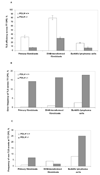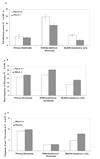Reduced efficiency and increased mutagenicity of translesion DNA synthesis across a TT cyclobutane pyrimidine dimer, but not a TT 6-4 photoproduct, in human cells lacking DNA polymerase eta
- PMID: 18634905
- PMCID: PMC2656611
- DOI: 10.1016/j.dnarep.2008.06.008
Reduced efficiency and increased mutagenicity of translesion DNA synthesis across a TT cyclobutane pyrimidine dimer, but not a TT 6-4 photoproduct, in human cells lacking DNA polymerase eta
Abstract
Xeroderma pigmentosum variant (XPV) patients carry germ-line mutations in DNA polymerase eta (poleta), a major translesion DNA synthesis (TLS) polymerase, and exhibit severe sunlight sensitivity and high predisposition to skin cancer. Using a quantitative TLS assay system based on gapped plasmids we analyzed TLS across a site-specific TT CPD (thymine-thymine cyclobutane pyrimidine dimer) or TT 6-4 PP (thymine-thymine 6-4 photoproduct) in three pairs of poleta-proficient and deficient human cells. TLS across the TT CPD lesion was reduced by 2.6-4.4-fold in cells lacking poleta, and exhibited a strong 6-17-fold increase in mutation frequency at the TT CPD. All targeted mutations (74%) in poleta-deficient cells were opposite the 3'T of the CPD, however, a significant fraction (23%) were semi-targeted to the nearest nucleotides flanking the CPD. Deletions and insertions were observed at a low frequency, which increased in the absence of poleta, consistent with the formation of double strand breaks due to defective TLS. TLS across TT 6-4 PP was about twofold lower than across CPD, and was marginally reduced in poleta-deficient cells. TLS across TT 6-4 PP was highly mutagenic (27-63%), with multiple mutations types, and no significant difference between cells with or without poleta. Approximately 50% of the mutations formed were semi-targeted, of which 84-93% were due to the insertion of an A opposite the template G 5' to the 6-4 PP. These results, which are consistent with the UV hyper-mutability of XPV cells, highlight the critical role of poleta in error-free TLS across CPD in human cells, and suggest a potential involvement, although minor, of poleta in TLS across 6-4 PP under some conditions.
Figures


Similar articles
-
DNA polymerase zeta cooperates with polymerases kappa and iota in translesion DNA synthesis across pyrimidine photodimers in cells from XPV patients.Proc Natl Acad Sci U S A. 2009 Jul 14;106(28):11552-7. doi: 10.1073/pnas.0812548106. Epub 2009 Jun 29. Proc Natl Acad Sci U S A. 2009. PMID: 19564618 Free PMC article.
-
Highly error-free role of DNA polymerase eta in the replicative bypass of UV-induced pyrimidine dimers in mouse and human cells.Proc Natl Acad Sci U S A. 2009 Oct 27;106(43):18219-24. doi: 10.1073/pnas.0910121106. Epub 2009 Oct 12. Proc Natl Acad Sci U S A. 2009. PMID: 19822754 Free PMC article.
-
UV-induced mutations in epidermal cells of mice defective in DNA polymerase η and/or ι.DNA Repair (Amst). 2015 May;29:139-46. doi: 10.1016/j.dnarep.2015.02.006. Epub 2015 Feb 16. DNA Repair (Amst). 2015. PMID: 25733082
-
Multiple two-polymerase mechanisms in mammalian translesion DNA synthesis.Cell Cycle. 2010 Feb 15;9(4):729-35. doi: 10.4161/cc.9.4.10727. Epub 2010 Feb 23. Cell Cycle. 2010. PMID: 20139724 Review.
-
Replication of damaged DNA: molecular defect in xeroderma pigmentosum variant cells.Mutat Res. 1999 Oct 22;435(2):111-9. doi: 10.1016/s0921-8777(99)00047-6. Mutat Res. 1999. PMID: 10556591 Review.
Cited by
-
DNA damage tolerance in stem cells, ageing, mutagenesis, disease and cancer therapy.Nucleic Acids Res. 2019 Aug 22;47(14):7163-7181. doi: 10.1093/nar/gkz531. Nucleic Acids Res. 2019. PMID: 31251805 Free PMC article. Review.
-
Site-directed Mutagenesis (Y52E) of POLH Affects Its Ability to Bypass Ultraviolet-induced DNA Lesions in HaCaT Cells.West Indian Med J. 2014 Aug;63(4):307-11. doi: 10.7727/wimj.2014.063. Epub 2014 Apr 22. West Indian Med J. 2014. PMID: 25429473 Free PMC article.
-
Separate domains of Rev1 mediate two modes of DNA damage bypass in mammalian cells.Mol Cell Biol. 2009 Jun;29(11):3113-23. doi: 10.1128/MCB.00071-09. Epub 2009 Mar 30. Mol Cell Biol. 2009. PMID: 19332561 Free PMC article.
-
Redundancy of mammalian Y family DNA polymerases in cellular responses to genomic DNA lesions induced by ultraviolet light.Nucleic Acids Res. 2014;42(17):11071-82. doi: 10.1093/nar/gku779. Epub 2014 Aug 28. Nucleic Acids Res. 2014. PMID: 25170086 Free PMC article.
-
DNA lesion identity drives choice of damage tolerance pathway in murine cell chromosomes.Nucleic Acids Res. 2015 Feb 18;43(3):1637-45. doi: 10.1093/nar/gku1398. Nucleic Acids Res. 2015. PMID: 25589543 Free PMC article.
References
-
- Friedberg EC, Walker GC, Siede W, Wood RD, Schultz RA, Ellenberger T. DNA Repair and Mutagenesis. Washington DC: ASM Press; 2006.
-
- Vreeswijk MP, van Hoffen A, Westland BE, Vrieling H, van Zeeland AA, Mullenders LH. Analysis of repair of cyclobutane pyrimidine dimers and pyrimidine 6-4 pyrimidone photoproducts in transcriptionally active and inactive genes in Chinese hamster cells. J. Biol. Chem. 1994;269:31858–31863. - PubMed
-
- Tung BS, McGregor WG, Wang YC, Maher VM, McCormick JJ. Comparison of the rate of excision of major UV photoproducts in the human HPRT gene of normal and xeroderma pigmentosum variant cells. Mutat. Res. 1996;362:65–74. - PubMed
-
- Nakajima S, Lan L, Kanno S, Takao M, Yamamoto K, Eker AP, Yasui A. UV light-induced DNA damage and tolerance for the survival of nucleotide excision repair-deficient human cells. J. Biol. Chem. 2004;279:46674–46677. - PubMed
-
- Johnson RE, Prakash S, Prakash L. Efficient bypass of a thymine-thymine dimer by yeast DNA polymerase Pol eta. Science. 1999;283:1001–1004. - PubMed
Publication types
MeSH terms
Substances
Grants and funding
LinkOut - more resources
Full Text Sources
Miscellaneous

